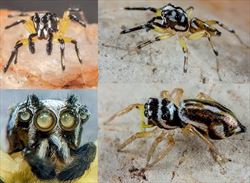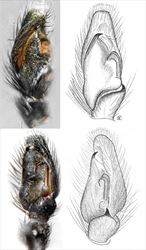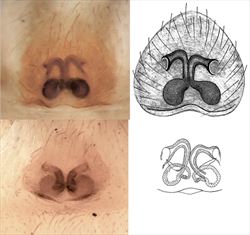
Examples of live Phintella
Illustrator (and ©) I.R. Macaulay

Aspects of the general morphology of Phintella
Illustrators (and ©)B.J. Richardson (CSIRO), R. Whyte (LR)

Palp morphology of Phintella
Illustrators (and ©) R. Whyte, M. Zabka (diag.) (QMB)

Epigyne morphology of Phintella
Illustrators (and ©) B.J. Richardson (CSIRO), B. Patoleta (diag.)
Phintella Strand, 1906
Taxonomy
Phintella is found in the Oriental Region, mostly in China, but also Russia, Africa, Southern Europe, the Near East, the Philippines, Myanmar, Indonesia and New Caledonia. Only one Australian species has been described: Phintella monteithi. Further information can be found in Richardson and Żabka (2017) and Whyte and Anderson (2017). Related Laurasian genera also reaching Australia include Cosmophasis, Menemerus and Afraflacilla.
Description
Phintella monteithi is a small to medium-sized spider, ranging in body length from 3 to 6 mm. The carapace is high, tapering to the rear from behind the posterior lateral eyes. The head, viewed from above, is nearly rectangular, widest behind the posterior lateral eyes. The upper side of the carapace features a striking black and white pattern, different for the male and female. The abdomen is elongate-ovate in the female and narrowing more towards the rear in the male. The male dorsal abdomen is mostly orange with a white central spot, the female has more black on the abdomen and a central, lengthways-running white stripe. The face of the male has thick patches of white hair, below the anterior lateral eyes, in a V extending downward between the anterior median eyes and downward on the faces of the paturons (bases of the chelicerae). Chelicerae have a single (unident) retromarginal tooth and three or more promarginal teeth. All legs are long and slender with the first pair of legs slightly longer than the fourth pair.
The male’s palp is jet black, with a short embolus arising on the distal edge of the tegulum, curving slightly clockwise. The tegulum is long, with a proximal lobe and a distinctive tegular bulge on the lower lateral edge close to the short, pointed retro-lateral tibial apophysis.
The female has a diamond-shaped epigyne with a single atrium which has a faint midline and patchily sclerotised edges. The copulatory openings are near the centres of each half of the atrium. Insemination ducts lead down either side of the midline to the roundish spermathecae. The female’s pedipalps are bright yellow.
Biology
Phintella spp. have been found in litter and on foliage from rainforest to woodland.
Distribution
Phintella spp. occur widely across coastal eastern Australia from the Daintree to southern Tasmania.
References
Richardson, B.J. & Żabka, M. 2017. Salticidae. Arachnida: Araneomorphae. Canberra, Australian Faunal Directory. Australian Biological Resources Study, at https://biodiversity.org.au/afd/taxa/SALTICIDAE.
Żabka, M. 2012. Phlegra Simon, 1876, Phintella Strand 1906 and Yamangalea Maddison, 2009 (Arachnida: Araneae: Salticidae) — new species and new generic records for Australia. Zootaxa 3176, 61-68.
Whyte, R. & Anderson, G. 2017. A field guide to the spiders of Australia. Clayton: CSIRO Publishing 451pp.
* The information sheet should be read in the context of the associated diagrams and photographs. Diagrams explaining anatomical terms can be found in the ‘Salticidae’ pictures at the beginning of the list of genera.